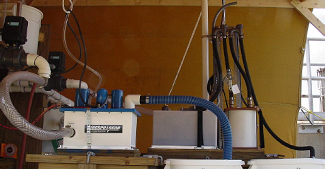Marine Sanitation Devices (MSDs)
The Clean Water Act (CWA) is the centerpiece of federal legislation addressing pollution in U.S. waters. Under section 312 of the CWA, sewage discharges from vessels are controlled in part by regulating the equipment that treats or holds the sewage: marine sanitation devices (MSDs).
What is an MSD?

For purposes of the CWA, an MSD is "any equipment for installation on board a vessel which is designed to receive, retain, treat, or discharge sewage, and any process to treat such sewage." 33 U.S.C. 1322(a)(5) (PDF) (10 pp, 170 K).
Who is required to use an MSD?
- Section 312 of the CWA requires the use of operable, U.S. Coast Guard-certified MSDs on board vessels that are 1) equipped with installed toilets, and 2) operating on U.S. navigable waters (which include the three mile territorial seas). 33 U.S.C. 1322(h)(4) (PDF) (10 pp, 170 K).
- The MSD requirements do not apply to vessels that do not have installed toilets (e.g., vessels with "porta-potties").
Who regulates MSDs under section 312?
- The U.S. Environmental Protection Agency (EPA) and the U.S. Coast Guard jointly regulate MSDs under CWA section 312.
- The EPA has issued regulations setting performance standards for MSDs (40 CFR 140 (PDF)(5 pp, 229 K)), which address fecal coliform and total suspended solids.
- The Coast Guard has issued regulations (33 CFR 159 (PDF)(18 pp, 273 K)) governing the design, construction, certification, installation and operation of MSDs, consistent with the EPA's standards.
- To learn more about the Coast Guard's certification requirements for MSDs, please visit the Coast Guard's website.
Are there different types of MSDs?
Yes, the Coast Guard categorizes MSDs into three types:
| Type I | Flow-through treatment devices that commonly use maceration and disinfection for the treatment of sewage | May be installed only on vessels less than or equal to 65 feet in length |
Must produce an effluent with:
|
|---|---|---|---|
| Type II | Flow-through treatment devices that may employ biological treatment and disinfection (some Type II MSDs may use maceration and disinfection) | May be installed on vessels of any length |
Must produce an effluent with:
|
| Type III | Typically a holding tank where sewage is stored until it can be discharged shore-side or at sea (beyond three miles from shore) | May be installed on vessels of any length | No performance standard; must "be designed to prevent the overboard discharge of treated or untreated sewage or any waste derived from sewage." 33 CFR 159.53(c) (PDF)(2 pp, 163 K)). |
What is the role of the states in implementing the CWA section 312 vessel sewage program?
- Unlike CWA section 402 National Pollutant Discharge Elimination System (NPDES) program, states have a more limited role in implementing the section 312 vessel sewage program.
- Except for houseboats (as defined at CWA section 312(f)(1)(B)), states may not adopt or enforce any statute or regulation with respect to the design, manufacture, installation or use of any MSD on any vessel subject to the requirements of section 312. (33 U.S.C. 1322(f) (PDF) (10 pp, 170 K)).
- States may request that the EPA establish no-discharge zones for vessel sewage (areas in which both treated and untreated sewage discharges from vessels are prohibited). States may establish such zones themselves after required findings are made by the EPA.
- The provisions of section 312 are enforced by the Coast Guard, and may be enforced by the states as well. (33 U.S.C. 1322(k) (PDF)(10 pp, 170 K)).
Are there certain waters where the discharge of treated sewage is prohibited?
- Yes. Under the CWA and the implementing regulations, vessels are prohibited from discharging any sewage, whether treated by an MSD or not, into the following types of water bodies:
- A water body that has been designated as a no-discharge zone.
- Freshwater lakes, reservoirs, or other impoundments whose entrance point(s) and exit point(s) are too shallow to allow vessels with installed toilets to enter and leave.
- Rivers that do not support interstate traffic by vessels subject to section 312. See 40 CFR 140.3(a)(1) (PDF)(2 pp, 183 K).
